| FLATBED PRINTS |
 |
|
Wide-format flatbed printers are an essential tool for any commercial printing business. They enable printing directly onto rigid surfaces (called substrates) therefore the creation of a wide range of signage for local and international businesses alike.
With the ability to print on a wide range of both hard and flexible substrates from paper to vinyl to aluminium, it is easy to see why flatbed printers are a valuable mechanism. This article explores the many applications of flatbed printers, from fine art to product displays.
|
| INKS |
 |
|
Early flatbed printers used solvent inks, but today most flatbed printers on the market use UV curable inks. The following chart outlines the difference between these inks and the printers that use them.
|
SOLVENT INKS |
UV CURABLE INKS |
| PRICE |
The inks are relatively inexpensive |
The printer and the inks are quite expensive. |
| SUBSTRATES |
A moderate range of materials that do not require pre-coating. The inks "eat away" at the surface, essentially etching the ink into the substrate for a very durable bond. Edible inks are available. |
A wide range of materials that do not require pre-coating. The inks sit on the surface of the print and is not ideal for substrates that must stretch, such as vinyl for vehicle wraps. Inks better suited to flexible materials are available. |
| DRYING TIME |
Dry by evaporation, so production time must be allotted for this. |
Cured by UV light within the printer - dry as soon as printing is completed. |
| VENTILATION |
The fumes are toxic, so the area must be well-ventilated. |
The fumes are odorless and non-toxic, so ventilation is not an issue. |
| IMAGE RESOLUTION |
In general, very good resolution due to smaller drip size, useful for gradients and small details. |
Some have lower resolution than solvent printers, though high quality UV printers are comparable or surpass solvent resolution. |
| COLORS |
No white ink is available, so printing on dark substrates is avoided. |
A white ink option is available for most printers, allowing true color reproduction on colored substrates (though the UV light may be unable to penetrate very dark substrates). |
| DURABILITY |
Can stand up to handling because the ink has etched into the substrate. Will fade over time. |
Completely light-fast once cured, so will not fade. Because the ink is raised, however, it cannot stand up to excessive handling or abrasion. |
When directly compared, the color options, and lack of drying time and toxic fumes makes it easy to understand why UV curable inks are beginning to eclipse solvent inks.
As mentioned in the chart, UV curable ink printers often come with a white ink option. This is a rare feature in ink jet printing in general - most ink heads to not include it, and any areas that are white in the digital image simply remain the color of the substrate (as is the case in the solvent ink printers).
Other inks beyond the traditional CMYK (cyan, magenta, yellow, black) cartridges are also available with most UV curable printers. Some combination of light cyan, light magenta, and various blacks may be offered. The number of print cartridges depends on the printer: either four, six, or eight. A clear varnish cartridge may also be added as a protective finisher.
Because UV curable inks sit on the substrate and are slightly textured, they scatter light and therefore produce a matte finish. To counteract this, a clear gloss ink is sometimes included for print jobs that require a certain level of shine. Unfortunately, this does made UV inks less popular for products that require a smooth feel.
|
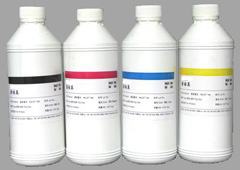
UV Curable inks
|
| WHAT DOES UV CURABLE MEAN?
|
 |
|
Printers that use UV curable inks have a built in UV light that "cures" the ink as it passes. This process is a photochemical reaction; the inks, which are mixed with compounds called photoinitiators, harden immediately upon exposure to the lightsource.
Unlike solvent inks, which can shrink as much as 50% during the evaporation/drying, UV curable inks do not lose any thickness or volume. As a result, there is less waste, not to mention the lack of toxic fumes, as mentioned in the chart above. Once cured, the inks are light-fast, which means they can be exposed to external light and climates without fear of fading.
There are two types of UV curing systems: "regular" mercury vapor, and LED.
- Mercury Vapor UV light has a wider wavelength and so more reactivity with the inks, which means the curing speed is very quick, leading to better productivity. They are best suited to high-volume workspaces.
- LED UV light has a narrower wavelength, causing less reactivity, which means curing takes longer, and productivity is slower. However, LED has other advantages: the lights have a longer lifespan, use less heat than mercury vapor, and are more energy efficient. Because of this, many manufacturers are working to improve the productivity of LED lights. Currently, however, they are best suited to lower-volume workspaces.
|
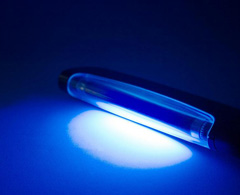
UV light source
|
| UV CURABLE FLATBED PRINTERS
|
 |
|
The following chart compares some of the foremost mid-level UV curable flatbed printers currently on the market.
| BRAND & MODEL |
MAXIMUM
WxLxD |
RESOLUTION |
SPEED |
INK COLORS |
PRICE |
| Mimaki JFX200 |
51" x 98" x 2" |
Up to 1200 dpi |
Up to 25 m² per hour |
4 color (plus optional white) and clear |
Approx. $78,000 |
| Canon Océ Arizona 6160 |
98" x 120" x 2" |
Up to 1440 dpi |
Up to 155 m² per hour |
6 color, plus white |
Approx. $450,000 |
| Inktec Jetrix |
94" x 118" x 4" |
Up to 1440 dpi |
Up to 60 m² per hour |
4 color, plus white |
Undetermined |
| HP Scitex FB550 |
64" x 120" x 2.5" |
Up to 1200 dpi |
Up to 38.9 m² per hour |
6 color, plus white |
Approx. $87,000 |
| Durst Rho 1012 |
96" x 201" x 2.75" |
Up to 1000 dpi |
Up to 490 m² per hour |
6 color, additional orange, green, violet |
Undetermined |
| EFI H1625 (LED) |
65" x 130" x 2" |
Up to 1200 dpi |
Up to 458 m² per hour |
4 color, plus white |
Approx. $130,000 |
| Roland VersaUV LEJ-640 |
64" x 140" x .5" |
Up to 1440 dpi |
Up to 12 m² per hour |
4 color, plus white and gloss |
Approx. $70,000 |
| Roland VersaUV LEJ-640FT |
64" x 98" x 6" |
Up to 1440 dpi |
Up to 12 m² per hour |
4 color, plus white and gloss |
Approx. $90,000 |
| Agfa Anapurna M2540 FB |
60" x 100" x 1.75" |
Up to 1440 dpi |
Up to 45 m² per hour |
6 color, plus white |
From $90,000 |
|
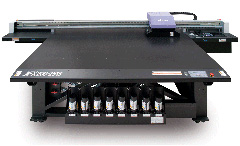
Mimaki JRX200
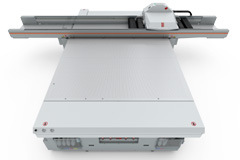
Canon Océ Arizona
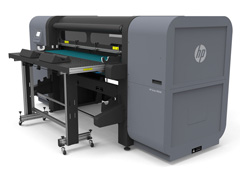
HP Scitex
|
| FLATBED SUBSTRATES
|
 |
|
Many flatbed printers are Hybrids, which means they allow for printing on both flexible, rolled substrates and flat, rigid substrates. They may have an internal roll attachment, and a table that slides below the print head for hard materials, or the permanent bed/table may have an attachment that holds the roll.
The ability of flatbed printers to print to rolled materials as well as rigid is a useful quality, though some research has found that flexible substrates are more likely to skew as they pass along the rollers on the bed/table. In a dedicated roll-based printer, this will not occur.
PAPER
While images most commonly printed on paper materials (fine art, photographs, etc.) are probably best left to a dedicated Giclée roll-based printer, there are commercial applications that call for paper advertising. Often, advertisements that will be placed in light boxes or within outdoor frames do not need to be printed on rigid material.
VINYL
Window decals, vehicle wraps, and banners all use vinyl as a substrate. As pointed out above, UV curable ink is not ideal for vinyl that must be stretched after it is printed, because the inks sit on the surface and may crack when expanded. However, improvements are being made in this department, and there are vinyl applications that do no require stretching. Solvent inks are ideally suited to flexible vinyls.
Some vinyl has an adhesive backing, allowing the finished print to be adhered to a window, wall, or even to the floor. In the case of windows, however, this means the signage must be placed on the outside, which will inevitably shorten its lifespan. This is where clear, flexible plastics come in handy - the mirror image can be printed so the print can be placed on the inside of the window, with the correct text or artwork showing to those passing by.
Read more about uses for vinyl and other flexible substrates in our article All About Banners.
FOAM BOARD
Flatbed printers are useful for printing on inexpensive rigid surfaces such as foam board (also called foam core), gatorboard, and sintra (a semi-rigid PVC plastic). Though the former two materials are unlikely to last as long as the inks themselves, these materials are ideal for short-term projects because the cost can be equivalent to the usage.
These substrates are ideal for one-time trade show signage, short-term indoor events, and non-commercial applications such as large fundraisers or party announcements.
METAL
Printing directly onto metal is very useful. It means eliminating the added step of dry mounting a printed, flexible substrate onto blank metal - the only way in the case of a roll-based printer - which saves time and reduces material costs. If white ink is not used, fine art prints and even high quality advertisements receive a unique, artistic touch, since all white areas will instead appear as brushed aluminium, copper, or whatever metal is used.
Since solid metal can be costly, aluminium di-bond is another option. Di-bond is a composite made up of two thin sheets of aluminium with a core of polyethylene. It is a common dry mounting surface and is a high quality alternative to pure metal.
WOOD
Wood is another substrate that can create very interesting results through direct printing. Much like metal, white areas of the image will show the natural grain of the wood, giving the print a soft, warm tone. In the case of wood, however, the printer's maximum substrate thickness (dictated by the space between the printer bed and the print head) comes into play. Some printers can handle thicknesses of only 0.4 inches, while other can print materials up to 2.5 inches thick.
GLASS/CERAMIC
Reviews on the ability of UV curable and solvent printers to print on glass and ceramic are mixed, and depend wholly on the ink. While some inks are formulated specifically to print well on glass, others may require the surface to be treated prior to printing. In generally, the results will vary depending on the type and quality of the glass and the inks. If there is any white in the digital image, white ink is certainly required when printing on glass, which will often eliminate solvent printers.
Shower doors and business windows or room dividers are popular applications for glass printing.
TEXTILES
While thin rolls of fabric material are liable to skew when printed on a flatbed printer, there are firmer textile rolls and rigid woven materials. Both UV curable and solvent inks (as well as other, less common flatbed printer inks like latex) can print on short pile carpet materials for trade shows, offices, and storefronts.
|
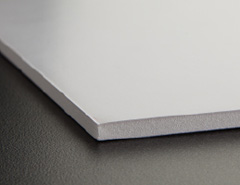
Foam board
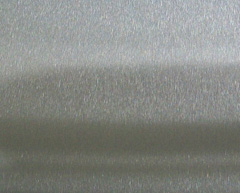
Aluminium sheeting
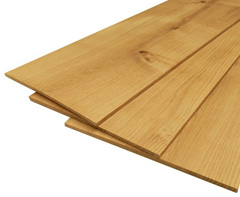
Wood
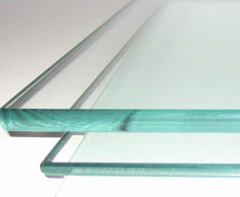
Sheet glass
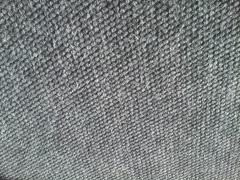
Carpet textiles
|
|
Flatbed printers offer consumers a wide range of products that are unattainable with a regular, roll-based model. Now that the quality of flatbeds can equal or even rival most traditional ink jet printers, many print companies are choosing to offer these services to commercial customers in addition to the mostly private consumer base reached by Giclée printers.
At KeenART Media, we supply a wide range of services and products to fulfil many of your fine art and advertising needs. For more information about our offerings, please contact us. Our knowledgeable staff is always happy to answer your questions and offer advice for your next printing project.
|
|
© 2002-2024 - KeenART Media Ltd.
|
|
| |
|

